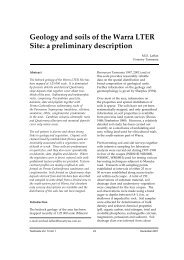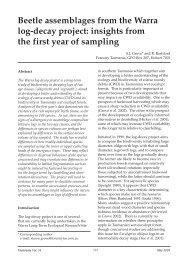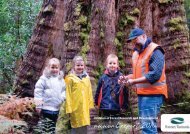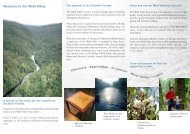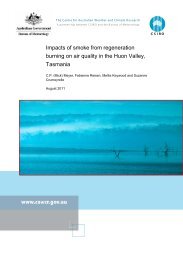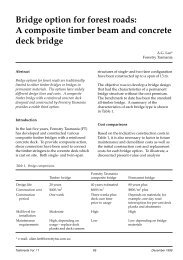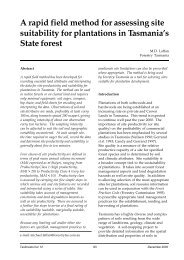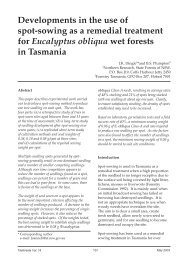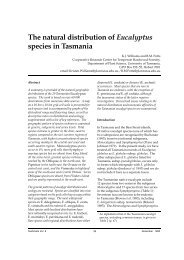sustainable forest management - Forestry Tasmania
sustainable forest management - Forestry Tasmania
sustainable forest management - Forestry Tasmania
Create successful ePaper yourself
Turn your PDF publications into a flip-book with our unique Google optimized e-Paper software.
2007/08 PERFORMANCE SUMMARY<br />
Below is an overview of <strong>Forestry</strong> <strong>Tasmania</strong>’s performance<br />
for 2007/08. This is as measured against our <strong>sustainable</strong><br />
<strong>forest</strong> <strong>management</strong> performance objective and targets.<br />
A more comprehensive summary of our detailed trend<br />
data is available in Appendix one.<br />
✓ Positive performance as based on progress against<br />
our targets and indicators.<br />
X More effort is required to improve our performance.<br />
Biological diversity<br />
✓ On 1 June 2007, <strong>Forestry</strong> <strong>Tasmania</strong> announced the<br />
end to the practice of converting native <strong>forest</strong>s to<br />
plantations. This announcement exceeded the target<br />
set by the <strong>Tasmania</strong>n Community Forest Agreement<br />
to phase out conversion of native <strong>forest</strong>s on public<br />
land by 2010.<br />
✓ Good progress continues to be made in the<br />
development of alternatives to clearfelling. In<br />
2007/08, partial logging, including variable retention<br />
contributed to 67 per cent (1424 hectares) of the<br />
total oldgrowth area harvested (2114 hectares).<br />
✓ Four research projects were undertaken that<br />
specifically covered threatened species (flora and<br />
fauna).<br />
Productive capacity<br />
✓ A total of 304,000 m 3 of high quality sawlog was<br />
supplied to <strong>Forestry</strong> <strong>Tasmania</strong>’s customers. This<br />
volume is within the <strong>sustainable</strong> production level as<br />
was confirmed by the preparation of the 2007 fiveyearly<br />
review of <strong>sustainable</strong> high quality eucalypt<br />
sawlog supply from <strong>Tasmania</strong>n state <strong>forest</strong> as<br />
required under Clause 98 of the <strong>Tasmania</strong>n Regional<br />
Forest Agreement (RFA).<br />
✓ An additional 3179 hectares of hardwood<br />
plantation was created bringing the total hardwood<br />
plantation estate to 52,718 hectares.<br />
✓ Out of the 10,207 hectares of native <strong>forest</strong><br />
regenerated, 98.1 per cent (10,010 hectares) met the<br />
prescribed standard.<br />
X 8400 ha (3100 hectares of clearfelled area and 5300<br />
hectares of partially harvested area) was treated<br />
for site preparation. 89 per cent of this area (94 per<br />
cent of clearfell and 86 per cent partial harvest areas<br />
respectively) achieved the site preparation quality<br />
standard. This reflects a slight decrease of four per<br />
cent on the previous year’s achievement.<br />
✓ 141 hectares of commercial native <strong>forest</strong> thinning<br />
was completed, 133 hectares of which met the<br />
quality standard. This is an achievement rate of 94<br />
per cent and compares highly favourably with the<br />
five-year average of 50 per cent.<br />
X In the 2007/08 year, 3387 hectares was sown with<br />
eucalypt seed. 1435 ha (42 per cent) of this area<br />
achieved the seed provenance quality standard.<br />
This is a six per cent decrease when compared<br />
with the five-year average of 48 per cent of area<br />
achieving the standard. The main cause of not<br />
achieving the desired standard was as a result of<br />
insufficient on-site seed being available.<br />
X From the post logging residue assessments<br />
conducted in 93 harvesting areas, the standard of<br />
less than five merchantable tonnes per hectares was<br />
achieved in 92 per cent of the areas sampled. This<br />
represents a five per cent decrease on last year’s<br />
performance.<br />
Ecosystem health and services<br />
✓ Following the cessation of the use of 1080, native<br />
<strong>forest</strong>s managed by <strong>Forestry</strong> <strong>Tasmania</strong> are generally<br />
chemical free, as pesticides (herbicides, insecticides<br />
and fungicides) are only used in exceptional cases<br />
where introduced weeds, pests and disease pose an<br />
unacceptable risk to the environment.<br />
✓ For commercial eucalypt and pine plantations,<br />
pesticides are required to reduce weed and pest<br />
infestations to acceptable levels. All of the 139 water<br />
samples collected and submitted for independent<br />
testing following the application of pesticides were<br />
free of chemicals.<br />
X The ratio of Spinosad (<strong>Forestry</strong> <strong>Tasmania</strong>’s preferred<br />
organic insecticide used instead of cypermethrin) has<br />
shown an unfavourable decline over the past three<br />
years. In other words, the area treated with Spinosad<br />
over the three-year period 2005/06 to 2007/08 was 29<br />
per cent, three per cent and 1.5 per cent respectively.<br />
✓ Through correlation of the days on which <strong>Forestry</strong><br />
<strong>Tasmania</strong> was conducting planned burns, it is unlikely<br />
any of these high intensity burns contributed to<br />
the Air Quality Particulate Standard (PM 10 ) being<br />
exceeded.




